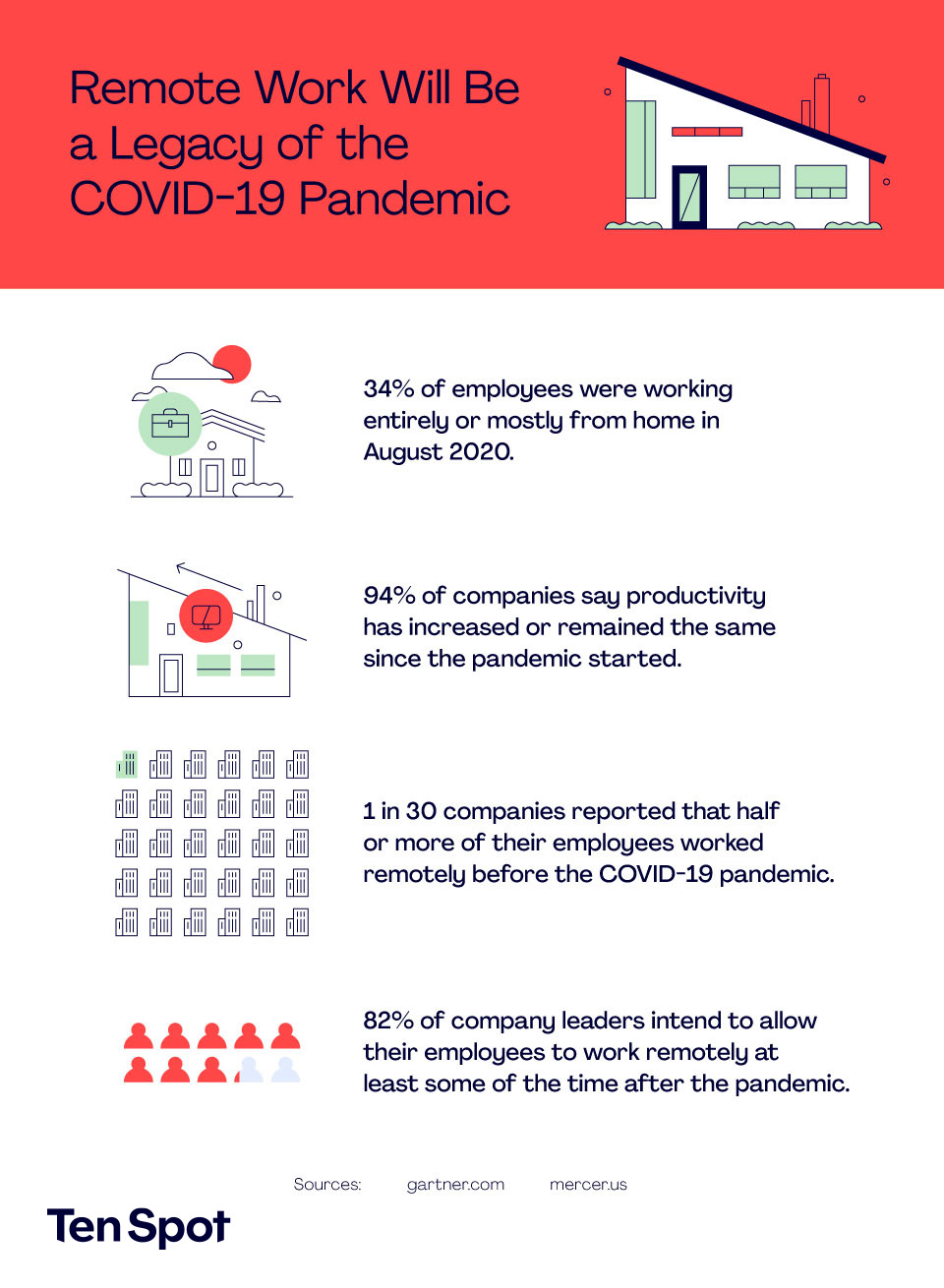Remote work isn’t new, but in 2020, it’s become a reality for many more companies. Leaders who once feared remote work would tank productivity have been pleasantly surprised during the COVID-19 pandemic. According to a Mercer study conducted in August 2020, 94 percent of employers have seen the same or better productivity since implementing remote work solutions for their employees.
Even if newly remote workforces are unlikely to see a drop in productivity, your business isn’t guaranteed a boost. To increase productivity, you must lean into the advantages of remote work by allowing greater flexibility and shifting to results-driven expectations. On the flip side, you’ll also contend with new challenges. For instance, workers may struggle more with work-life balance and engagement without a shared physical workspace. Here’s how to help ensure your organization sees a productivity boost with your transition to a remote workforce.
What Remote Work Looks Like in 2020 and Beyond
Researchers have documented higher productivity from remote workers in the past. In a 2014 experiment conducted by the Chinese travel agency Trip.com (formerly CTrip), call center workers who volunteered to work from home made 13.5 percent more calls than they did when working in the office. Plus, they had higher job satisfaction and half the usual turnover.
Remote work in 2020, however, may look different than in 2014. As the CTrip study leader Nicholas Bloom points out, the remote workgroup chose their situation: “They were all motivated to work from home effectively, and that’s how it should be.”
Nonetheless, 2020’s last-minute scramble to move large workforces to remote work seems to have paid off for most companies. One Gartner study suggests 82 percent of leaders plan to allow remote work to continue at least a few days a week after the pandemic subsides. These leaders don’t make this choice lightly. They have concerns. One third (30 percent) say maintaining company culture is their top concern. Other potential problems include sustaining productivity, providing a seamless employee experience, and maintaining parity between remote and in-office workers.

You need more than reliable Wi-Fi and video conferencing software to ensure your team becomes a remote-work success story. You may need a completely different management strategy. If your company has newly remote workers, it’s worth learning how to engage them and encourage them to be productive. If you succeed, your team may want to work from home long after the pandemic quiets down.
Flexibility Is Key
The challenges of working remotely in 2020 are numerous. Parents are juggling childcare and virtual schooling. And employees may work in makeshift offices while sharing space with a spouse who’s also working from home. Most employees are getting used to video calls with dogs barking, children screaming, doorbells ringing, and lawn equipment buzzing in the background. In this new climate, leaders must learn how to manage a remote team with flexibility and understanding.
To keep your team as productive as possible, give people grace to reschedule a meeting, run an errand during work hours, or invite an infant to sit on their knee during a video call. Be clear about what you expect. For instance, you may need your employees to hit their client-facing deadlines or check ten things off a to-do list each week. Allow other tasks to have more flexible deadlines. Some weeks your team may accomplish just the minimum. In other weeks, they’ll accomplish more. According to data collected by the time-tracking software company RescueTime, remote workers are 20 percent more likely than office workers to complete all of their daily tasks .
Flexibility is not just about location. Consider other ways to be flexible with your employees. For instance, maybe you can offer flexible scheduling or hire contract or gig workers to help reduce workloads. Leave it up to managers to increase flexibility on a team-by-team basis or roll out new policies organization-wide.

Don’t Just Balance, Integrate
Before 2020, work-life balance was a mental health goal of employees and employers. But without the physical boundary of an office and commute separating work and home life, balancing a professional and personal life is even harder. One way to make lemonade out of pandemic lemons is to encourage your employees to strive for work-life integration.
While work-life balance emphasizes hard boundaries between a job and personal life, work-life integration allows for more fluidity. An employee may be able to attend a kid’s soccer game during normal work hours or empty their inbox before their coworkers sign on to take a long family lunch.
To make work-life integration a realistic goal for your employees, encourage them to put both work and personal activities on their calendars so they (and their team) can see what their days look like. Plan meetings early if multiple attendees are required to attend.
Finally, consider that some boundaries should be firm. If your team has trouble finding times to meet, enforce a few hours each day when they must be available for meetings. Or if your team needs to field customer calls, create an “on call” schedule that ensures both flexibility and coverage.

How to Engage a Remote Team
One of the greatest challenges for a company with a remote workforce is to keep employees engaged. At the office, employers can host breakroom gatherings over donuts or pay for a casual catered team lunch. But without face-to-face interactions and watercooler conversations, keeping your team tuned in can be challenging. According to a Zapier study in April 2020, 42 percent of remote workers missed socializing with their coworkers, and many would prefer to come to the office at least some days.
To keep your remote team engaged, don’t rely on spontaneous conversations. Schedule regular one-on-one calls with your direct reports and encourage them to do the same with their colleagues. Host virtual happy hours, coffee calls, and digital lunches. Consider providing gift cards or stipends for your employees to buy food and beverages to enjoy at these events. Encouraging your employees to socialize may cost a few dollars and take some planning, but it’s worth it to keep up much-needed social interactions at work. One study shows that when employees have work friendships, companies have fewer safety issues, higher profits, and more engaged customers.
Reassess Meetings and Communication
According to a study by RescueTime, the average office worker spends less than two thirds (five hours in an eight-hour work day) of their time on work devices completing the core tasks that define their job. So, for a graphic designer that’s five hours per day creating. For a developer, it’s five hours writing code.
Remote workers, however, spend an average of 4.7 percent more time on their core work each day. While that may not sound like much, it adds up to 58 hours more per year — which gives your company nearly 1.5 weeks of additional productivity.
Where do these extra hours come from? It turns out the time comes from the hours office workers generally spend on communication, including in-person meetings and writing emails. To get your remote team to spend more time on core work, turn a critical eye toward your meeting schedule.
How many hours does each member of your team spend in virtual meetings? Can you consolidate meetings or make it optional to attend? In fact, could a meeting be a group email or a quick chat on Slack or Teams instead? If so, start trimming.
If you can’t cut meetings or pair back on attendees, look for ways to make your meetings more efficient. Send out an agenda ahead of time to ensure people know what to expect. Outline how attendees should prepare for meetings. Finally, if you have extra time at the end of a meeting, consider other topics to tackle while the group is already gathered.
If you find that your team enjoys chatting about weekend plans or catching up on the latest pet antics or baby pictures, allow a few minutes at the beginning of each meeting for socializing, and then reel it in. Schedule more social video calls for other times and encourage people to talk casually then.
Prioritize Smart Breaks
Since moving to remote work, 80 percent of people say they can better manage interruptions, and 65 percent say their productivity has increased. When people have fewer interruptions, they can spend more time on core work. But workers can burn out if they forget to take enough breaks throughout the day.
Encourage your team to take more breaks by letting them know you don’t expect immediate responses to emails and messages. Show them you take plenty of breaks by dropping a message in a chat thread about getting up to grab another cup of coffee. Taking breaks helps employees maintain long-term productivity, but using those breaks strategically can boost it.
For even higher productivity, talk to your team about taking smart breaks. Encourage them to leave the room, get exercise, or soak up some vitamin D. Share invigorating stretches designed to combat office-chair slouch and keyboard shoulders.
It may seem counterproductive to encourage your employees to take more breaks to boost productivity, but stepping away from the desk can help workers clear their heads, renew their energy, and spark fresh inspiration.
The Bottom Line: It’s a Brave New Remote World
The pandemic has forced many employees into working from home even though some would prefer to go to the office each day. These people may have a hard time finding quiet space at home or going for long periods without face-to-face contact with peers.
Leaders can boost productivity by leaning into the benefits of remote work, such as fewer interruptions and better work-life integration. Stay flexible where possible and don’t be afraid to rethink your meeting style and cadence to adapt to people’s schedules. Communicate often with your team to keep them engaged, and encourage them to take breaks and practice self-care.
COVID-19 has been a significant curveball for businesses, but don’t write off 2020 completely. Use the unexpected shift to a remote work environment to hone your leadership skills and learn new management styles because research suggests remote work is here to stay.








